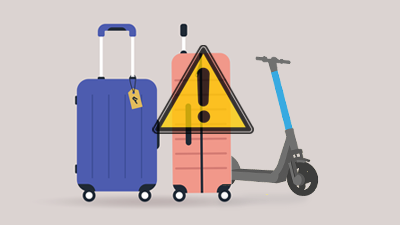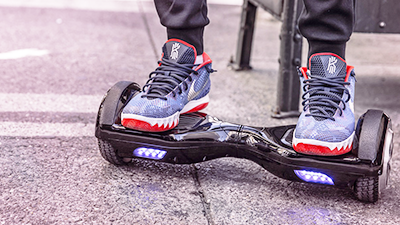Electronic devices we use in our everyday life can pose a safety risk when tr ansported by air. This is why there are certain items that can only be carried in your hand luggage, used on board of an aircraft under certain conditions, or may even be forbidden to take at all.
ansported by air. This is why there are certain items that can only be carried in your hand luggage, used on board of an aircraft under certain conditions, or may even be forbidden to take at all.
Remember: safety is a collective effort and you as passenger also have a role to play. Therefore, it is very important that you carefully read the dangerous goods information provided by the airline before your flight.
Airplane mode: on
In most cases, these days we can use our laptops, smartphones, e-readers, tablets, etc. during a great part of the flight (exceptions apply, for example, when taking off and landing). However, it is worth remembering that portable electronic devices may interfere with the airplane equipment, and this differs from one type of aircraft to another. This is why airlines usually require you to switch such devices to “airplane mode” at all times.
Lithium batteries
Lithium batteries are a component of many items in our daily lives. Your mobile phone, your laptop, tablet or even camera are powered by rechargeable lithium-ion batteries. When damaged, short-circuited or overheated, these batteries can catch fire. This is why you should carry your portable electronic devices (PEDs) such as cameras, laptops and phones in your hand baggage (carry-on), and not in your checked baggage.
Spare batteries and power banks must always be transported in your carry-on baggage and never in your checked baggage. They must be individually protected to prevent short-circuits, and it is only allowed to carry a maximum of two per person in total. They should not be recharged while on board the aircraft.
Although not recommended, if you really need to pack your electronic devices in your checked baggage, you must make sure that the devices are completely switched off and protected from accidental activation. Some airlines completely ban such items from checked baggage.
Whether in your carry-on or checked baggage – the battery must not exceed a certain watt-hour (Wh) and should be bought from original retailers only and never from untrustworthy sources. This assures that the battery has been properly tested.
-
Use of "smart" luggage
Like many objects in our daily life, from phones to toasters, luggage has also become “smart” in the past years. Smart luggage is normally equipped with lithium battery(ies). Therefore, rules apply here as well. The battery(ies) should not exceed a maximum of lithium content of 0.3 grams or 2.7 Wh. If they do exceed the limit, you have two options: bring the bag with you in the cabin as carry-on, or, if that is not possible, you must remove the battery(ies) and bring it (them) with you in the cabin under the same conditions that apply to spare batteries and power banks.
-
Watch out for malfunctioning warning signs
If a battery is swollen, too hot or producing smoke, these are clear signs that something is wrong with it. If you notice anything different in your battery during the flight or in the airport, you should immediately contact a cabin crew member or a member of the airport’s staff.
-
Damaged, Defective or Recalled Lithium Batteries
Lithium-ion cells and batteries that have been identified by the manufacturer as being defective for safety reasons, or that have been damaged, that have the potential of producing a dangerous evolution of heat, fire or short circuit (e.g. those being returned to the manufacturer for safety reasons) can be very dangerous and passengers should avoid carrying them.
E-cigarettes
Electronic cigarettes (e-cigarettes) must always be kept in your hand baggage. It is also forbidden to recharge them while on board the aircraft.
Leisure transportation devices
 In general, leisure transportation devices powered by lithium batteries, like hoverboards, electronic skateboards and self-balancing devices, are not allowed either in a checked bag or in the cabin, as the batteries have a rating of 100 Wh or more. It is therefore safer to leave these items at home when flying.
In general, leisure transportation devices powered by lithium batteries, like hoverboards, electronic skateboards and self-balancing devices, are not allowed either in a checked bag or in the cabin, as the batteries have a rating of 100 Wh or more. It is therefore safer to leave these items at home when flying.
Stay informed
Create an account and follow us on EASA Light to stay up to date on the latest news related to safety in aviation and more!
